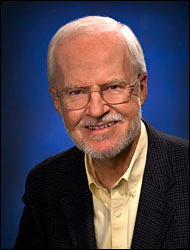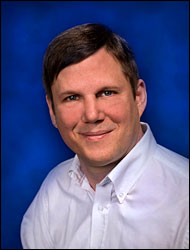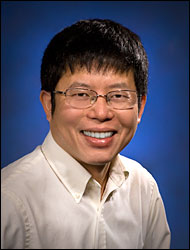Three Brookhaven Lab Physicists Named American Physical Society Fellows
January 10, 2011
UPTON, NY — Three scientists at the U.S. Department of Energy’s Brookhaven National Laboratory have been named Fellows of the American Physical Society, the world’s second largest organization of physicists. Election to APS Fellowship is limited to no more than one half of one percent of its membership in a given year, and election for this honor indicates recognition by scientific peers for outstanding contributions to physics.
The 2010 Fellows from Brookhaven are:
Anthony Baltz
“For theoretical prediction of constraints on solar neutrino mass and mixing parameters from the Earth effect and for theoretical contributions to ultra-peripheral interactions with relativistic heavy ion reactions.”
In 2002, Brookhaven Lab chemist Ray Davis Jr. won the Nobel Prize in Physics for detecting solar neutrinos. But in research that spanned from 1967 to 1985, Davis found only one-third of the neutrinos that standard theories predicted. Theorists offered a solution to this neutrino puzzle: They indicated that neutrinos had mass and could mix while traversing the Sun, changing to a type not detectable by the Davis experiment. Baltz then calculated how the neutrinos could change while traversing the Earth, leading to possible day-night and seasonal variations in other planned neutrino experiments. This research helped to determine the values of neutrino masses and mixing.
More recently, Baltz began a theoretical investigation of particle interactions at Brookhaven’s world-class accelerator, the Relativistic Heavy Ion Collider (RHIC). At RHIC, physicists investigate the collisions of heavy ions that create quark-gluon plasma, a type of matter that is believed to have existed just microseconds after the Big Bang. Ions often miss colliding, but because of their accompanying strong electromagnetic fields, still produce interesting physics. These fields create huge numbers of electron-positron pairs out of a vacuum, knock neutrons out of ions, and make quark-anti-quark pairs in the form of mesons. Baltz developed theory and models in order to calculate the rates of these processes. In particular, the neutrons knocked out from ions can be detected and compared with predictions in order to help determine beam luminosity, or rate of particle interactions, and identify experimental events at RHIC.
Baltz received a B.S. in physics from Spring Hill College in Alabama in 1966 and a Ph.D. in physics from Case Western Reserve University in 1971. He joined Brookhaven Lab in 1971 as a research associate in the Physics Department, and he rose through the ranks to become a senior physicist in 2001. Baltz was elected a Fellow of the American Association of the Advancement of Science in 1989.
Michael Blaskiewicz
“For theoretical and experimental work leading to the first successful implementation of bunched beam stochastic cooling in a high energy ion collider.”
As tightly packed bunches of charged ions zip around RHIC in opposite directions billions of times at nearly the speed of light, they tend to spread out. As a result, the number of head-on particle collisions declines, decreasing data for experimenters. Blaskiewicz, with Brookhaven Lab physicist Mike Brennan, led the team that developed an efficient method to reduce this beam diffusion by using electric fields to “kick” the diffused charged particles back to denser bunches. Although this technique, called stochastic cooling, has been used in low-energy accelerators, Blaskiewicz and Brennan were the first to make it work at high energy. This feat will allow physicists from around the world working at RHIC to gather more data to study the extremely hot, dense matter that is thought to have existed a few millionths of a second after the Big Bang.
Blaskiewicz earned a B.S. in physics from the University of Connecticut, Storrs, in 1983, and a Ph.D. in physics from Cornell University in 1991. He was a Fellow in Accelerator Technology at Brookhaven Lab in 1991 and joined the Laboratory as an assistant physicist in 1992. Blaskiewicz received a Brookhaven Science and Technology Award in 2007. He is currently a physicist in the Lab’s Collider-Accelerator Department.
Zhangbu Xu
“For major contributions in the study of high-density nuclear matter at RHIC, especially the development of improved technologies for particle identification, and new techniques for the reconstruction of short-lived resonances culminating in the discovery of the heaviest know anti-nucleus, the anti-hypertriton.”
Xu played an important role in the successful development of two detector upgrades to the STAR detector at RHIC that enable researchers to measure the velocity of particles and to identify rare muon particles. He also showed that using the time-of-flight system that he helped to upgrade to identify electrons could broaden research possibilities beyond its original design.
Particles that decay very quickly and cannot be directly detected are described as resonances. Xu played a leading role in identifying these particles emerging from nucleus-nucleus collisions by measuring their daughter particles produced during their decay. Similarly, exotic antimatter hypernuclei can be detected by STAR through their decay daughters of anti-nuclei and pion particles. Xu is one of the leading STAR authors in the discovery of the anti-hypertriton, the most massive anti-nucleus and first anti-hypernucleus known to date, laying the groundwork for a new frontier in physics.
Xu earned a B.S. in physics from the University of Science and Technology of China in 1994 and a Ph.D. in physics from Yale University in 1999. After serving as a research associate at Yale University from 1999 to 2001, Xu joined Brookhaven Lab as an assistant physicist. He is currently a physicist in Brookhaven’s Physics Department. Xu won a Presidential Early Career Award for Scientists and Engineers, as well as a similar Department of Energy award, in 2004. He was designated Kavli Frontiers Fellow by the National Academy of Sciences in 2007, and he received Brookhaven Lab’s Science and Technology Award in 2010.
2011-11219 | INT/EXT | Newsroom












